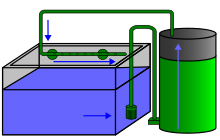External filter
The external filter is used in the aquarium hobby to treat the aquarium water. In addition to removing coarse or fine suspended particles from the water, the purpose of filtration is also the biological degradation of toxic waste materials by microorganisms that inhabit the filter material.
Only the suction opening and the outlet of an external filter are located inside the basin. The actual filter container can be next to, behind or under the aquarium . The water flows into the filter through the suction opening, which is often protected by a basket to prevent fish and plant parts from being sucked in. There it is pumped through various filter materials and returns to the basin through the air outlet.
One of the specific advantages of an external filter over an internal filter is that different filter materials can be used. The manufacturers offer different filter materials. These are mostly ceramic filter media of different sizes, foams, special filter floss or activated carbon. If different materials are used in a filter, they are layered on top of one another in the interior of the filter container according to their pore size, with the finest filter medium forming the top.
The external filter is used in tanks from a medium size, in aquariums with a very large volume, a sufficient filter capacity must be ensured. An internal filter is suitable for small to medium-sized pools .
An external filter increases the risk of water damage. The filter is usually installed below the zero level of the aquarium and works as a lifter . If a leak occurs, in the worst case the aquarium will be emptied until the siphon draws air (the water level falls below the height of the suction nozzle).

